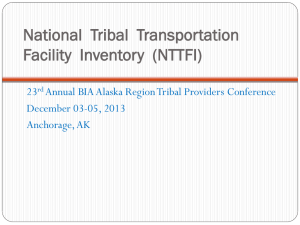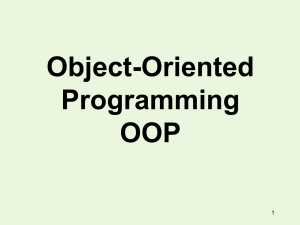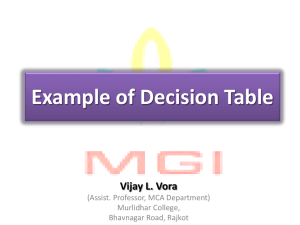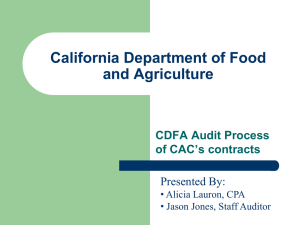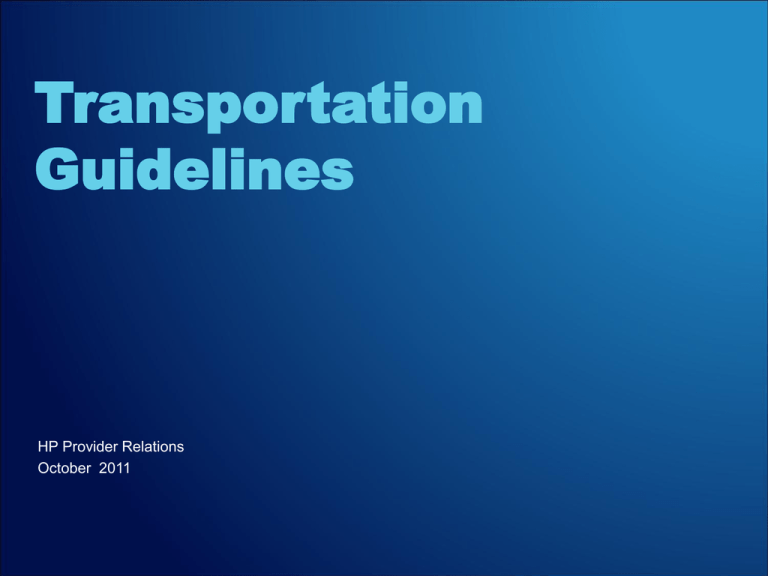
Transportation
Guidelines
HP Provider Relations
October 2011
Agenda
– Session objectives
– Provider enrollment responsibilities
– Types of transportation services
– Transportation specialties and billing codes
– QMB Only/Also
– Destination modifiers
– Prior authorization
– Mileage, multi-passengers and attendants
– Copayment amounts and exemptions
– Common denials
– Frequently asked questions
– Helpful tools
– Questions and answers
2
Transportation Guidelines
October 2011
Session Objectives
At the end of this session, providers will
understand:
– Enrollment and recertification document
requirements
– Impact of QMB-only
– Importance of origin and destination modifiers
– Prior authorization requirements
– How to bill for mileage, attendants, and waiting
time
– Required copayments and copayment
exemptions
– How to resolve common claim denials
3
Transportation Guidelines
October 2011
Learn
Enrollment Requirements
4
Transportation Guidelines
October 2011
Enrollment Responsibilities
– Providers should reference the Provider Type and Specialty
Matrix to determine the documentation required to enroll in, or
recertify for the Indiana Health Coverage Programs (IHCP)
•
http://provider.indianamedicaid.com/ihcp/ProviderServices/pdf/TR473IHCPProviderTypeSpecialtyMatrix.pdf
– Once enrolled, transportation providers must recertify annually
or based upon permits, certificates, and liability insurance
coverage periods
– Two reminder letters are sent to the providers, 60 and 30 days
prior to the recertification date
• To
ensure Recertification Notices are received, all addresses must be kept
up to date on the provider profile
5
Transportation Guidelines
October 2011
Enrollment Responsibilities
Seven specialties are associated with transportation providers:
6
•
260 – Ambulance
•
261 – Air ambulance
•
262 – Bus
•
263 – Taxi
•
264 – Common carrier ambulatory services (CAS)
•
265 – Common carrier nonambulatory services (NAS)
•
266 – Family member
Transportation Guidelines
October 2011
Enrollment Responsibilities
260 – Ambulance
261 – Air ambulance
– A copy of the Emergency Medical
Services (EMS) Commission certificate,
based on certificate end date, is needed
for enrollment and for the annual
recertification
7
Transportation Guidelines
October 2011
Enrollment Responsibilities
262 – Bus
– The Motor Carriers Services (MCS) certificate issued by the Indiana
Department of Revenue is required for both enrollment and annual
recertification in the IHCP
8
Transportation Guidelines
October 2011
Enrollment Responsibilities
263 – Taxi
– A document showing operating authority from a local governing body;
for example, a city taxi or livery license
– A copy of retail merchant’s certificate (unless nonprofit status)
– A copy of driver’s licenses for all drivers
– Proof of insurance indicated by local ordinances or, if unspecified by
local ordinance, a minimum of $25,000/$50,000 of public livery
insurance covering all vehicles used in the business
– Recertification:
9
•
Must submit a copy of documentation from the operating authority from the local
governing body (city taxi or livery license)
•
Must submit a copy of the renewed insurance policy prior to current insurance policy
expiration date
Transportation Guidelines
October 2011
Enrollment Responsibilities
264 – Common carrier ambulatory services (CAS)
265 – Common carrier nonambulatory services (NAS)
Not-for-profit
For profit
10
•
Motor Carrier Services certificate
from the Indiana Department of
Revenue
•
Certification of not-for-profit status
from the Internal Revenue Service
(IRS)
•
Copy of a valid driver’s license
•
Proof of insurance
•
Copy of a valid driver’s license
Transportation Guidelines
October 2011
Enrollment Responsibilities
266 – Family Member
– Approval from the local office of the
Division of Family Resources (DFR)
– Proof of insurance
– A copy of a valid driver’s license
11
Transportation Guidelines
October 2011
Define
Types of Transportation Services
12
Transportation Guidelines
October 2011
Types of Transportation Services
– Advanced Life Support – ALS
•
Care given at the scene of an accident, act of terrorism, or illness; care given during
transport; care given at the hospital by a paramedic or emergency medical technicianintermediate; and care that is more advanced than the care usually provided by an
emergency medical technician or an emergency medical technician-basic advanced
– Basic Life Support – BLS
•
BLS services do not include invasive medical care techniques or advanced life support
– Commercial or Common Ambulatory Service – CAS
•
Ambulatory (walking) members to or from an IHCP covered service
– Nonambulatory Service (Wheelchair Van) – NAS
•
Nonambulatory services when a member must travel in a wheelchair to or from an
IHCP-covered service
– Taxi
•
13
Taxi providers transport ambulatory members and may operate under authority from a
local governing body (city taxi or livery license)
Transportation Guidelines
October 2011
Definition of a Trip
– For billing purposes, a trip is defined as
transporting a member from the initial point
of pick-up to the drop off point at the final
destination
– Transportation must be the least expensive
type of transportation available that meets
the medical needs of the member
– Trips must be billed according to the level
of service rendered and not according to
the vehicle type
– Providers must bill for all transportation
services provided to the same member on
the same date of service on one claim form
14
Transportation Guidelines
October 2011
Definition of a Trip
– If the provider makes a round trip for the same member, same date of
service, and same level of base code, both runs should be submitted
on the same detail with two units of service to indicate a round trip
– Additionally, all mileage for the trip must be billed on the one detail
with the total number of miles associated for the roundtrip
– If the provider transports a member on the same date of service, but
different trip levels (for example the “to” trip was a CAS trip, and the
“return” trip was a NAS trip, with mileage for each base), these base
trips must be billed on two different claim forms with the corresponding
mileage for each base
15
Transportation Guidelines
October 2011
Multiple Destinations
– If the member is transported to multiple points in succession, the
provider may not bill for a trip between each point of the destination
– The following examples offer explanations of this concept:
• Example 1: A vehicle picks up a member at home and transports the member to the
physician’s office. This is a one-way trip.
• Example 2: A vehicle picks up a member from home and transports the member to the
physician’s office. The provider leaves, and later the same vehicle picks the member
up from the physician’s office and transports the member back to the member’s home.
This is considered two one-way trips.
• Example 3: A vehicle picks the member up from the physician’s office and transports
the member to the laboratory for a blood draw, waits outside the laboratory for the
member, and then transports the member home. This is a one-way trip, even though
there was a stop along the way. A stop along the way is not considered a separate trip.
16
Transportation Guidelines
October 2011
Perform
Billing for Services
17
Transportation Guidelines
October 2011
Billing Codes
260 – Ambulance
Code
Description
A0427
Advanced life support (ALS) emergency transport, level 1,
one or more interventions
A0426
ALS nonemergency transport, level 1, one or more
interventions
A0428
Basic life support (BLS), nonemergency transport
A0429
BLS, emergency transport
A0225
Neonatal transport, ambulance service, base rate one way
CPT copyright 2010 American Medical Association. All rights reserved. CPT is a registered trademark of the American
Medical Association.
18
Transportation Guidelines
October 2011
Billing Codes
260 – Ambulance
Code
Description
T2003
ALS nonemergency transport; level 1 (common carrier
ambulatory)
A0130
ALS nonemergency transport; level 1 (common carrier
nonambulatory)
T2003
BLS nonemergency transport; (common carrier ambulatory)
A0130
BLS nonemergency transport; (nonambulatory)
A0425 U1 U2
Ground mileage, per statute mile
Level 1 (ALS)
Level 2 (BLS)
A0420 U1
Ambulance service - waiting time
ALS one-half (1/2) hour increments
A0420 U1
Ambulance service - waiting time
BLS one-half (1/2) hour increments
19
Transportation Guidelines
October 2011
Billing Codes
261 – Air ambulance
Code
Description
A0431
Ambulance service, conventional air service, transport, one
way (rotary wing)
A0430
Ambulance service, conventional air service transport, one
way (fixed wing)
A0436
Rotary wing air mileage, per statute mile
A0431 QL
Ambulance service, conventional air service, transport, one
way (rotary wing); if the member is pronounced dead after
takeoff to point of pickup
20
Transportation Guidelines
October 2011
Billing Guidelines
261 – Air ambulance, A0431, A0431 QL, A0436
– Effective for rotary wing air
ambulance: for dates of service on or
after December 25, 2009, providers
are to bill for both the base rate and
mileage code
– Rotary wing air ambulance claims no
longer require an attachment for a
cost invoice after January 1, 2010
– Prior to January 1, 2010, rotary wing
air ambulance claims still require an
attachment
– Each code is reimbursed at a specific
rate per the IHCP fee schedule
– Refer to IHCP Provider Manual,
Chapter 8, Section 4
21
Transportation Guidelines
October 2011
Billing Codes
262 – Bus
Code
Description
A0110
Nonemergency transportation and bus, intrastate, or
interstate carrier
22
Transportation Guidelines
October 2011
Billing Codes
263 – Taxi
Code
Description
A0100 U4
Nonemergency transportation – taxi, suburban
A0100 UA
Taxi – 0-5 miles
A0100 UB
Taxi – 6-10 miles
A0100 UC
Taxi – 11 miles and up
A0100 TT UA
Taxi – 0 to 5 miles, multi-passenger
A0100 TT UB
Taxi – 6 to 10 miles, multi-passenger
A0100 TT UC
Taxi – nonregulated, multi-passenger, 11 miles or more
A0100 TK UA
Taxi – 0 to 5 miles, accompanying parent or assistant
A0100 TK UB
Taxi – 6 to 10 miles, accompanying parent or assistant
A0100 TK UC
Taxi – nonregulated, accompanying parent or assistant, 11
miles or more
23
Transportation Guidelines
October 2011
Billing Guidelines
263 – Taxi
– Taxi providers cannot transport outside the jurisdiction designated by
their city taxi license
– To transport outside the jurisdiction, the taxi provider must be enrolled
as a common carrier (provider specialties 264 and 265)
– If a taxi transports across county borders, the Indiana Department of
Revenue’s Motor Carrier Services Division must certify as a common
carrier
24
Transportation Guidelines
October 2011
Billing Codes
264 – Common carrier ambulatory service (CAS)
Code
Description
T2003
Common carrier ambulatory service – base rate
T2004
Common carrier ambulatory service – multiple passenger
T2001
Common carrier ambulatory service – accompanying parent
or assistant, base rate
A0425 U3
CAS mileage
T2007 U3
Level 3 CAS waiting time - in one-half (1/2) hour increments
25
Transportation Guidelines
October 2011
Billing Codes
265 – Common carrier nonambulatory services (NAS)
Code
Description
A0130
Wheelchair – Common carrier nonambulatory, base rate
A0130 TT
Wheelchair – Common carrier nonambulatory, multiple
passenger, base rate
A0130 TK
Wheelchair – Common carrier nonambulatory, accompanying
parent or attendant, base rate
A0425 U5
NAS Mileage
T2007 U5
Waiting time in one-half (1/2) hour increments
26
Transportation Guidelines
October 2011
Billing Codes
266 – Family member
Code
Description
A0090
Mileage for family member automobile transportation
27
Transportation Guidelines
October 2011
Billing Guidelines
Qualified Medicare beneficiary (QMB)
– QMB members are eligible for Medicare and Medicaid
•
The State pays the premium for Medicare Part B
– Two Types:
•
QMB-Only – The IHCP pays “only” the Medicare coinsurance and deductible
− QMB-Only members do not have transportation coverage for transportation
services that are not covered by Medicare
•
QMB-Also – The IHCP “also” pays for Medicare noncovered services in addition to the
coinsurance and deductible
− Services must be covered by Medicaid to be reimbursed
– Transportation providers must have QMB-Only members sign a waiver
prior to furnishing services not covered by Medicare
– The IHCP can pay for covered transportation services for QMB-Also
members without a waiver
28
Transportation Guidelines
October 2011
Billing Guidelines
Destination modifiers
– Providers must include the origin and destination modifiers with the
base rate procedure codes
– The first character of the two-digit modifier indicates the transport’s
place of origin
– The second character indicates the destination
– When a member is transported by more than one transportation
company on the same date of service, use of the modifiers helps to
prevent one of the claims from denying as a duplicate of the other
provider’s claim
– A list of appropriate modifiers can be found in the IHCP Provider
Manual in Chapter 8, Section 4
29
Transportation Guidelines
October 2011
Billing Guidelines
Destination modifiers
Modifier
Description
D
Diagnostic or therapeutic site, other than P or H
E
Residential, domiciliary, or custodial facility (nursing home,
not SNF)
G
Hospital-based dialysis facility (hospital or hospital-related)
H
Hospital
I
Site of transfer between types of ambulance
J
Nonhospital-based dialysis facility
N
Skilled nursing facility (SNF)
P
Physician office
R
Residence
S
Scene of accident or acute event
30
Transportation Guidelines
October 2011
Understand
Prior Authorization Requirements
31
Transportation Guidelines
October 2011
Prior Authorization Requirements
– Trips exceeding 20 one-way trips
per rolling 12-month period require
prior authorization (PA)
– Other services that require PA:
•
Air ambulance transportation
•
Airline transportation
•
Train transportation
•
Bus transportation
– Interstate transportation or
transportation services rendered by
a provider located out-of-state in a
nondesignated area
32
Transportation Guidelines
October 2011
PA Requirements
20 one-way trip - exemptions from PA requirement
– Emergency ambulance services
– Hospital admission or discharge
•
Transportation to a hospital for admission or from a hospital to home after discharge is
exempt from 20 one-way trip limitation
• All interhospital transportation services, except when the member has been
discharged from one hospital for admission to another hospital are non-covered
– Members on renal dialysis
•
Must have diagnosis code V56.0, V56.1, or V56.8
– Members in nursing homes
•
Must have diagnosis code V70.5
– Accompanying parent or attendant, and additional attendant
•
33
Procedure codes are excluded from 20 one-way trip limitation
Transportation Guidelines
October 2011
PA Requirements
– Trips of 50 miles or more one way
require PA
– When requesting PA for trips that are
greater than 50 miles one way,
providers need to make sure they
request authorization for the:
•
Base rate
•
Mileage
•
Wait time
– Signature stamps
•
34
Providers may use signature stamps on the PA
request form
Transportation Guidelines
October 2011
PA Contacts
Traditional Medicaid fee-for-service
– Traditional Medicaid fee-for-service PA requests are processed by
ADVANTAGE Health SolutionsSM
P.O. Box 40789
Indianapolis, IN 46240
•
1-800-269-5720
•
1-800-689-2759 (Fax)
– Submit PA requests on Web interChange PA Submission for fastest
way of obtaining PA
35
Transportation Guidelines
October 2011
PA Contacts
Care Select
Each care management organization
(CMO) is responsible for processing PA
requests for its respective Care Select
members:
– MDwise
P.O. Box 44214
Indianapolis, IN 46244-0214
•
1-800-356-1204
•
1-877-822-7186 (Fax)
– ADVANTAGE Health Solutions
P.O. Box 80068
Indianapolis, IN 46280
36
•
1-800-784-3981
•
1-800-689-2759 (Fax)
Transportation Guidelines
October 2011
PA Contacts
Risk-based managed care (RBMC)
– Providers must direct transportation service requests for RBMC
members to the appropriate managed care entity (MCE)
– Managed Health Services (MHS)
•
LCP Company provides services, but providers must call MHS for PA and notification
of transportation needs
• 1-877-647-4848
• managedhealthservices.com
– MDwise
•
Call MDwise for PA and notification of transportation needs
• 1-800-356-1204
• mdwise.org
– Anthem
•
1-800-508-7230 LCP Company
• Or Anthem 1-866-408-6132
• anthem.com
37
Transportation Guidelines
October 2011
Understand
Mileage, Multiple Passengers,
Attendants, and Waiting Time
38
Transportation Guidelines
October 2011
Mileage
– Transportation providers are expected to transport members along the
shortest most efficient route to and from a destination
– All transportation providers must document mileage on the driver’s
ticket using odometer readings or mapping software programs
– Reimbursement is available for mileage, in addition to the base rate,
under the following circumstances:
39
•
Ambulance providers are reimbursed for loaded mileage for each mile of the trip
regardless of the type level of service being billed
•
CAS and NAS providers are reimbursed for loaded mileage when the member is
transported more than 10 miles one way
•
Taxi providers are not reimbursed for mileage and are not required to submit mileage
with their claim; however, the mileage must be documented
Transportation Guidelines
October 2011
Mileage
– Although the first 10 miles of a CAS or NAS trip are automatically
deducted from each one-way trip, CAS and NAS providers must bill for
all mileage, including the first 10 miles to ensure proper
reimbursement
– For trips less than 10 miles, the provider is not required to bill
mileage; however, if mileage is billed, the mileage will process as a
denied line item
– Providers may bill fractional miles or round to the nearest mile, for
example, 15.7 miles can round to 16 miles
– Mileage codes and descriptions:
•
A0425
• A0425
• A0425
• A0425
40
U1
U2
U3
U5
Transportation Guidelines
ALS ground mileage, per statute mile
BLS ground mileage, per statute mile
CAS ground mileage, per statute mile
NAS ground mileage, per statute mile
October 2011
Multiple Passengers
– When two or more members are transported simultaneously from the
same county to the same vicinity for medical services, the second and
subsequent member transported in a single CAS or NAS vehicle is
reimbursed at one-half the base rate
– The full base code, mileage, and waiting time are reimbursed for the
first member only
– For example, no mileage should be billed in conjunction with T2004 Nonemergency transport; commercial carrier, multi-pass,
individualized service provided to more than one patient in the same
setting.
– The IHCP does not provide reimbursement for multiple passengers in
ambulances or family member vehicles
– Additional reimbursement is not available for multiple passengers
when the billing provider does not bill non-IHCP customers for these
services
41
Transportation Guidelines
October 2011
Accompanying Parent or Attendant
– Accompanying parent – When members younger than 18 years of age
need an adult to accompany them to a medical service, the provider
should bill the appropriate accompanying parent or attendant code
– Accompanying attendant – When adult members need an attendant to
travel with them for a medical service, the provider should bill the
appropriate accompanying parent or attendant code
– The following are guidelines for billing the accompanying parent or
attendant codes:
42
•
The procedure code for the base rate and the accompanying parent or attendant is
billed under the IHCP member identification number (RID)
•
Additional reimbursement is not available for accompanying parent or attendant when
the billing provider does not bill non-IHCP customers for like services
•
The provider must maintain documentation on the driver’s ticket to support that the
accompanying parent or attendant was transported with the IHCP member
This documentation must include the name, signature, and relation of the
accompanying parent or attendant
Transportation Guidelines
October 2011
Additional Attendant
– An additional attendant is needed in situations where the driver cannot
load the member without help, such as when wheelchair-bound
member lives upstairs and the residence has no wheelchair ramp
– The additional attendant who assists must be an employee of the
billing provider and is not required to remain for the trip
– Providers must document the need for an additional attendant on the
driver’s ticket
– Procedure codes:
43
•
A0130 U6 – Nonambulatory transportation; wheelchair van, U6 = additional attendant
•
A0424 – Extra ambulance attendant, ground (ALS or BLS) or air (fixed or rotary
winged); requires medical review
Transportation Guidelines
October 2011
Waiting Time
– Waiting time in excess of 30 minutes is reimbursable only when the
vehicle is parked outside the medical service provider, awaiting the return
of the member to the vehicle and if the member is transported 50 miles or
more one-way
– PA must be obtained for all codes associated with trips of 50 miles or
more one-way, including waiting time
– The IHCP does not cover the first 30 minutes of waiting time; however, the
total waiting time must be included on the claim, or the claim will not be
paid appropriately
– One unit of service is billed for each 30 minutes of waiting time (round to
nearest unit)
– Documentation, including start and stop times, must be maintained on the
driver’s ticket to support the waiting time billed
44
Transportation Guidelines
October 2011
Collect
Copayments
45
Transportation Guidelines
October 2011
Copayment
Amounts
Copayment
Description
$0.50
Services for which the IHCP pays $10.00 or less
$1.00
Services for which the IHCP pays $10.01 to $50.00
$2.00
Services for which the IHCP pays $50.01 or more
46
Transportation Guidelines
October 2011
Copayment
Exemptions
– Members younger than 18 years old
•
Package C members are not exempt from copayment requirements
– An assistant or accompanying adult traveling with a member younger
than age 18 years old
– Pregnancy indicated in form field 24H
– A place-of-service code indicating a medical institution (for example,
acute care hospital, intermediate care facility for the mentally retarded)
47
Transportation Guidelines
October 2011
Interpret
Common Denials
48
Transportation Guidelines
October 2011
Edit 4080
Mileage is not reimbursable unless the recipient is transported 11 miles
or more one way – please verify and resubmit
– Cause
•
System is deducting first 10 miles from the claim
– Resolution
49
•
The initial 10 miles are included in the base rate; mileage is only reimbursed for 11
miles or more
•
Providers should bill the total miles traveled for each trip
•
IndianaAIM will automatically calculate the appropriate mileage reimbursement
Transportation Guidelines
October 2011
Edit 5000
Possible duplicate
– Cause
•
Two round trips made in one day; the second trip denies as a duplicate
– Resolution
50
•
Indicate four units on one line in form field 24G for the base code
•
Combine total mileage on one line
•
Maintain documentation for the two separate round trips
Transportation Guidelines
October 2011
Edit 6803
Prior authorization required for one-way trips in excess of 20
– Cause
•
Member has already had 20 trips paid
– Resolution
51
•
Make sure to check for benefit limits reached on eligibility prior to transporting member
•
Submit a PA request for more trips then resubmit claim after approved PA is received
Transportation Guidelines
October 2011
Edit 4021
Procedure code is not covered for the dates of service for the program
billed – please verify and resubmit
– Cause
•
The procedure code billed is not covered for the date of service for the program billed
– Resolution
52
•
Verify that the correct procedure code has been billed
•
Note: a common cause for this error is billing incorrect modifiers; i.e. destination
modifiers with mileage codes (A0425 JN)
Transportation Guidelines
October 2011
Edit 4209
No matching pricing segment for the procedure/modifier combination
billed
– Cause
•
The procedure code/modifier combination does not exist on the pricing file
– Resolution
53
•
Verify that the correct procedure code has been billed
•
Note: a common cause for this error is billing incorrect modifiers; i.e. destination
modifiers with mileage codes (A0425 JN)
•
NOTE: Error codes 4021 and 4029 will almost always appear together on a denied
detail
Transportation Guidelines
October 2011
Clarify
Frequently Asked Questions
54
Transportation Guidelines
October 2011
Frequently Asked Questions
– Question: Why is the copayment deducted from my claim twice?
•
Answer: Do not enter copayment amounts in Field 29 of the CMS-1500 claim form.
The IHCP systematically deducts the copayment from the claim payment.
– Question: Why is a copayment deducted when the patient is
pregnant?
•
Answer: To bypass the copayment edit, indicate P in form field 24H of the CMS-1500
claim form.
– Question: Why is a copayment deducted when I transport a patient to
the hospital for admission?
•
55
Answer: Indicate the appropriate place of service in form field 24B of the CMS-1500
claim form.
Transportation Guidelines
October 2011
Frequently Asked Questions
– Question: Why do I receive denials for the 20-trip limit when I transport
a nursing facility patient?
•
Answer: To bypass the 20-trip limit denial, you must use diagnosis code V70.5 when
transporting a nursing facility patient.
– Question: If I make two trips in one day, why does the second trip deny
as a duplicate?
•
Answer: The IHCP will pay claims for both trips if you bill them on one detail line on the
CMS-1500 claim form. Indicate four units in form field 24G. Maintain documentation
for the two separate trips.
– Question: Why are 10 miles of each one-way trip deducted from my
mileage?
•
56
Answer: The initial 10 miles are built into the base rate. Mileage is only reimbursed for
11 miles or more.
Transportation Guidelines
October 2011
Find Help
Resources Available
57
Transportation Guidelines
October 2011
Helpful Tools
– IHCP Provider Web site at
indianamedicaid.com
– IHCP Provider Manual (Web, CD-ROM,
or paper)
– IHCP Provider Manual , Chapter 8,
Section 4
– Customer Assistance
•
1-800-577-1278, or
•
(317) 655-3240 in the Indianapolis local area
– Written Correspondence
•
HP Written Correspondence
P.O. Box 7263
Indianapolis, IN 46207-7263
– Provider Relations Field Consultant
•
58
Contact information is available on the IHCP
Provider Web site
Transportation Guidelines
October 2011
Q&A

